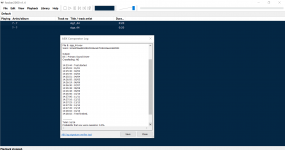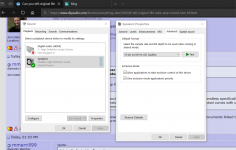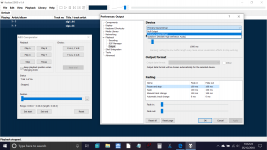That's not the impression I picked up from your other posts on this topic
So much misinformation - I don't know if it is intentional or just not interested in reading the documents linked to many times before to inform yourself before posting such misinformation?
Your good at finding what you want to see. You did say "forum" ABX again didn't you? They often have a few cheats and as I help point out computer/software/soundcard issues. So yes I don't pay that much attention to many.
I have told specifically John Curl numerous times in the past to stop equating all blind testing to ABX, try anything, take days with your own equipment. It always gets back to sighted vs blind. You don't seem to find those posts.
I read the ITU document, downloaded the files, and might have even posted the pictures and Jakob agreed (or at least he seemed to) that undithered 44.1/16 was not that useful in these days of the Benchmark, etc.
I asked for an actual test that you might agree used an approved of protocol. Take for instance the one where Jan and my DIY 8-legs microphone beat the tube guys at the Triode Fest (maybe someone still has a link somewhere). I simply meant an actual equipment evaluation. The AES has done some but they are almost always counter-indicative of what certain people want to see, maybe that's the real problem.
BTW - I'm sorry if one of your articles included some conclusive equipment evaluations I missed them, and I admit I'm not that interested in the academic articles on statistics or psycho-acoustics you tell me which tests are valid I'll trust you.
Last edited:
I read the ITU document, downloaded the files, and might have even posted the pictures and Jakob agreed (or at least he seemed to) that undithered 44.1/16 was not that useful in these days of the Benchmark, etc.
.
Undithered test files are close to useless, especially when we go down with level of the test tone, like -60dBFS for dynamic range measurement. Arta and Audacity are for free and both can generate and save dithered tones. I do not know why to bother with undithered signals in 2018 if they were obsolete in 2000.
These are the settings I used, and with it being a laptop there aren't many options.
This is fine. You could activate resampler in Foobar, for sine test 96/16. Resampler (DSP parameters) to 44100Hz, ultra mode.
I have posted 44.1/16 test tones earlier today. For the new tones, no resampling needed. I can see you already got 16/16 with them great! 😀
You are pretty persistent, but that's fine 😀. I hope you were able to read between the lines and deduce from what is happening and posted 🙂.
Sometimes persistency is needed. 😉
Btw, imE "reading between the lines" does not really help when discussing specifics of a statistical test analyis method. 🙂
<snip>
As Mooly was the only one who passed the sine test with 8/8 (though I would prefer 16/16) and posted a valid ABX record, he is the only one whose test result on music samples I take serious. Am I clear enough?
Clear enough, but absolutely not related to the topic we were discussing (not meant offensive, just straight forward)
You raised the specific question about this point:
"I have asked again about summation of results because I did not know I can make a sum of results of 8 participants. To me it is not intuitive. "
It does not depend on "Mooly" or "Pano" or whoever did a positive result.
It depends on whether it is correct to sum up the results of "the eight" if no single/multiple positive results were reached.
So, i am at a loss why you (seem to) refuse answering my question about this specific point.
Do you now know why (and in which case and for what reason) you can make a sum of results of 8 participants?
What you described in your post is a different topic, it is related to the question if a listener´s result is more trustworthy if he got the "sine test" right. I´d question that assumption, because the "sine test" is a onedimensional test, while doing an evaluation with music as stimulus is a multidimensional test.
This is fine. You could activate resampler in Foobar, for sine test 96/16. Resampler (DSP parameters) to 44100Hz, ultra mode.
I have posted 44.1/16 test tones earlier today. For the new tones, no resampling needed. I can see you already got 16/16 with them great! 😀
Thanks Pavel 🙂
Jakob, I am sorry but we have a different way of thinking. I think that the results make sense only in case they were achieved on the equipment that has an ability to keep the difference, i.e. it reproduces the signals well enough (what is well enough measurements tell), i.e. must have distortion much lower than is the distortion of test signals or samples. Ears are tested, not equipment.
So in case there is one person with good equipment to me the sum of results of him is fine. If there is a mix of persons where some of them have equipment that is unable to distinguish between the signals because of their system high intrinsic distortion, then the sum of results of those persons is maybe statistically correct but makes no sense to me. I see it as analogy of "incorrect coin".
I am sorry but this would be my last post on this point, as I find the endless discussion on this subject useless.
So in case there is one person with good equipment to me the sum of results of him is fine. If there is a mix of persons where some of them have equipment that is unable to distinguish between the signals because of their system high intrinsic distortion, then the sum of results of those persons is maybe statistically correct but makes no sense to me. I see it as analogy of "incorrect coin".
I am sorry but this would be my last post on this point, as I find the endless discussion on this subject useless.
the sine files quickly showed that equipment used for the test could be questioned, i could get positive result (not perfect) with Avacado and Apricot but definitely failed with the sine files.
am i to think that if i had a better sound card and passsed the sine test that my results would have better with Av&Ap or worse?
and if you score perfect with the sine file but can't reliably differentiate Av&Ap what does that say?
am i to think that if i had a better sound card and passsed the sine test that my results would have better with Av&Ap or worse?
and if you score perfect with the sine file but can't reliably differentiate Av&Ap what does that say?
Last edited:
Oh, here we go again with the old fallback excuse - tell me exactly what I have misinterpreted in what you said or this just remains another of the oft used attempts at dodgingYour good at finding what you want to see.
Maybe, I'm wrong but I seem to remember you suggesting people 'prove' their listening via blind tests. Did you mean non-forum blind ABX tests? If so what tests?You did say "forum" ABX again didn't you? They often have a few cheats and as I help point out computer/software/soundcard issues. So yes I don't pay that much attention to many.
And how do you evaluate these 'other' blind tests - you believe the person that they have achieved a positive result? Based on your mentioning cheats above, I can't quiet fathom what you are suggesting? Maybe you are suggesting this to JC because he says he finds blind tests don't work for him & you know your request is just a canard. If not then specify exactly what would satisfy you - as Jakob2 already asked you but you failed to respond.I have told specifically John Curl numerous times in the past to stop equating all blind testing to ABX, try anything, take days with your own equipment. It always gets back to sighted vs blind. You don't seem to find those posts.
Please link to the ITU-R BS.1116 that has downloadable files?I read the ITU document, downloaded the files, and might have even posted the pictures and Jakob agreed (or at least he seemed to) that undithered 44.1/16 was not that useful in these days of the Benchmark, etc.
If you've actually read the ITU guidelines & read the posts of both Jakob & i, then you should know what's needed - I don't know why you ask the same question over & over?I asked for an actual test that you might agree used an approved of protocol. Take for instance the one where Jan and my DIY 8-legs microphone beat the tube guys at the Triode Fest (maybe someone still has a link somewhere). I simply meant an actual equipment evaluation. The AES has done some but they are almost always counter-indicative of what certain people want to see, maybe that's the real problem.
If you don't put in the work reading the specifications & aren't really interested in psychoacoustics then there's no point in me or anyone else attempting to have a useful discussion with you on this topic.BTW - I'm sorry if one of your articles included some conclusive equipment evaluations I missed them, and I admit I'm not that interested in the academic articles on statistics or psycho-acoustics you tell me which tests are valid I'll trust you.
And yet you seem to always butt into threads that have psychoacoustics at it's core - maybe because of your lack of reading or care in understanding the topic that you don't realize this?
Last edited:
some do seem to have a vested interest in invalidating tests!
this is starting to feel like a Tom Clancy novel spies and double agents....
this is starting to feel like a Tom Clancy novel spies and double agents....
If people just stated that such forum run ABX testing was a bit of fun & not meant to have any significance beyond sighted listening then there's no problem but despite all evidence, people cling to some concept that forum run ABX testing is of a higher value.some do seem to have a vested interest in invalidating tests!
What's the problem with this that makes people so fixated on forum run ABX testing?
Please listen to the files and tell me which one is the original file and also which one you prefer sonically. It would be nice if you also could add a foobar ABX protocol, but it is not a necessary condition, I am not forcing you to do it, just asking if possible.
mmerill - What is the problem that makes you so fixated on it's non-validity. You still haven't said. Just vague complaints and criticisms of anyone asking you for more info.
That's as bad as those who claim to hear differences but will never take a blind test. Or those who claim faults with the software but provide no proof.
What is you major complaint other than you think they are overrated?
That's as bad as those who claim to hear differences but will never take a blind test. Or those who claim faults with the software but provide no proof.
What is you major complaint other than you think they are overrated?
If people just stated that such forum run ABX testing was a bit of fun & not meant to have any significance beyond sighted listening
Do you have a link to an ITU spec for sighted listening protocol?
To conduct subjective assessments in the case of systems generating small impairments, it is
necessary to select an appropriate method. The “double-blind triple-stimulus with hidden reference”
method has been found to be especially sensitive, stable and to permit accurate detection of small
impairments. Therefore, it should be used for this kind of test.
Jacob posted the link to an ITU site that included the spec and some recommended sound samples separately. I analysed the decay of a flute note from one of them. The tread was closed of course. If you are saying I made this up or I am a liar then I can just put you on my ignore list and we can move on.
Last edited:
mmerill - What is the problem that makes you so fixated on it's non-validity. You still haven't said. Just vague complaints and criticisms of anyone asking you for more info.
That's as bad as those who claim to hear differences but will never take a blind test. Or those who claim faults with the software but provide no proof.
What is you major complaint other than you think they are overrated?
Look at his website! At least the bits which are not "Lorem ipsum". Heavily involved in selling woo, so presumably afraid of anything that could prick the bubble.
Maybe it is because you never offer anything concrete and positive, but merely criticise what others have done. You rarely answer a direct question but instead direct people to other sources. Now maybe you genuinely believe that unless we all achieve the equivalent of an undergraduate degree in psychoacoustics (which you have?) we have nothing useful to say about audio testing, but I suspect that is not the real issue.mmerrill99 said:If you've actually read the ITU guidelines & read the posts of both Jakob & i, then you should know what's needed - I don't know why you ask the same question over & over?
You are to psychoacoustics what JC is to circuits: someone who claims to be an expert, and is rude and condescending to those you consider not experts. The big differences between you and him is that he does sometimes offer real advice, and we know that he has a track record of successful design over many years. Hence we take him more seriously than you, even though we find his tone annoying at times.
Looking at "his" website would be more enlightening if he confirmed that it is indeed his website. Thus far he has declined any invitation to confirm or deny this.cliffforest said:Look at his website!
Last edited:
website where? who's?
i thought getting presented with complex math was bad enough now i gotta learn both latin and modern references...
i thought getting presented with complex math was bad enough now i gotta learn both latin and modern references...
- Home
- General Interest
- Everything Else
- Can you tell original file from tube amp record? - test


